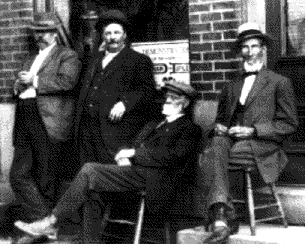Introduction
By Jed Perl
(Aperture)
The present volume is chock-a-block full of these experiments, forty-two photographs in all, and --- after all these many years of photographers diddling around with subject and object --- most of them don't make it into the photography sweepstakes. He may have been trying to get dada onto the page, but it simply doesn't seem as earthshaking now as it did back then. (On the other hand, those of us who have been exposed to his motion pictures know the taut sensuality that he could create with a single turning dreamy model, and manage to sustain for the entire run of the film.) He would have been better off to stick to movies, or to the reality that black-and-white photographs can create with such devastating directness.
 Le Violin d'Ingres [above] or the photograph of Arnold Schoenberg [right] are the exceptions rather than the rule in this anthology; they show his technique at its best. Mr. Perl says that Ray's photographs reflect the "glee of spontaneous discovery." Perhaps. But he is even more on the mark when he says that Ray's photographs are "reminiscent of the daguerrotypes of the 1840's" because "we are impressed with a sense of loss --- the passage of the moment that the photographer has recorded --- and a sense of gain --- the perpetuation of that moment."
Le Violin d'Ingres [above] or the photograph of Arnold Schoenberg [right] are the exceptions rather than the rule in this anthology; they show his technique at its best. Mr. Perl says that Ray's photographs reflect the "glee of spontaneous discovery." Perhaps. But he is even more on the mark when he says that Ray's photographs are "reminiscent of the daguerrotypes of the 1840's" because "we are impressed with a sense of loss --- the passage of the moment that the photographer has recorded --- and a sense of gain --- the perpetuation of that moment."
Know Me By Now
Buddhist Poet Monks
Of China
Red Pine and
Mike O'Connor,
Editors
(Wisdom)
How in hell are we to judge if the translation is any good --- especially given our Mandarin extends no further than "Give me some shrimp in black bean sauce" and "The journey of a thousand miles begins with a single step." What we are left with, in other words, is solely the ability to judge this as Pure Poetry, and forget where it comes from.
For example, "Thinking of Retired Scholar Wu on the River," by Chia Tao:
- Since you set sail for the state of Min,
the moon has pased from full to full again.
Autumn wind arises on Wei River;
falling leaves fill Ch'ang-an.
I recall the evening together ---
suddenly thunder, then cold rain.
Odd your orchidwood oar hasn't yet returned;
news of you ends at ocean clouds.
You and I don't want to be pegged as another Rush Limbaugh, now, do we? We want to keep our minds open, charitably open, and try to experience all that the world out there has to give us, and not spew out a Rushesque rage that flows from pure, pissed-off ignorance. If we look at "Retired Scholar Wu" as a piece of poetry, words together on the page that should mean something to us (and to poor Wu, gone off somewhere with his orchidwood oar), but, in truth, we're left with very little. The state of Min? Dunno...where the hell is Min? (Is it next to Wen?) The Wei River? Well, we look it up in our trusty atlas --- and we can't even find it. (Is it one of them places the Communists decided to rename to make it unrecognizable to honkies like us --- putting a Kafka twist even on the world of maps?)
According to the notes provided by the translators, Min and Wei are both in the Shensi Province. Great. We know where they are, but what then? "Orchidwood oar signifies a boat," the notes tell us (we figured that one) and then, "Chia Tao indicates the moon by ch'an ch'u, or 'the toad that lives in the moon.'" Hum. Does this mean that Tao thinks of his old friend Retired Scholar Wu as a bit of a toad? We hope not, because it detracts from what little message-of-loss remaining in the poem.
We're not just trying to be silly here. Worthy verse should be worthy --- no matter what language it came from, no matter what language it is translated into. Thus, if Mr. O'Connor wants to give us some feel for the art of 9th Century Chinese poetry of the Shensi School, he should be translating it in such a way that we, poor westerners that we are, get it. But what we have here is nothing but international gibberish, and if we want poetic gibberish, take us down to the Santa Monica Coffee & Confusion, where noisy poets get up and declaim, noisily, for hours.
The editors mention Ezra Pound's translations of Li Po's verse from fifty years ago, and you might take a moment to look up one of these, viz: The River Merchant's Wife: A Letter. Pound was able to pull off his translations because (1) he chose poems with stories, sometimes heart-rending stories, that transcend the ages, and (2) he did some shaping --- going beyond a reverence for the original words, which makes it possible for us to get to the original message. It's the difference between
-
At sixteen you departed,
You went into far Ku-to-yen, by the river of swirling eddies,
And you have been gone five months.
The monkeys make sorrowful noises overhead.
and
- I recall the evening together ---
suddenly thunder, then cold rain.
Odd your orchidwood oar hasn't yet returned;
news of you ends at ocean clouds...
The sentiments are the same, but one seems far more potent (and tragic) than does the other --- and we suspect it has something to do with translation.
Street
Blues
The Decline of
Small-Town America
Richard O. Davies
(Ohio State)
What is it about America 1900 - 1950 that attracted them, and attracts us, so powerfully? Is it our envy of a world that didn't know words like "smog," "drive-by shootings," "ecological disaster," "gated communities," "television?" Is it the dream of a community of people who thought that taking a walk downtown was entertainment enough --- knowing, too, that they could send the kids down (alone!) on their bicycles, at night, to pick up a loaf of bread; a place where, instead of calling the cops, or Washington, the community seemed to take care of its own problems?
Or is it, more simply, that those of us who grew up in the small towns of America know, and know all too well, what we --- and the world --- have lost through the aging and dying of those spacious, fresh, generous, achingly spare old towns.
Davies states that it was the combination of automobiles, radio (later, television), and the Depression that did them in. The car because when they needed something, people could choose to shop in Dayton or in Cincinnati instead of around the corner. The radio because it told them how much better life was in other worlds, making national information so much more important than local. The Depression, because, for the first time for most rural Americans, the local or state governments didn't have the power nor the finances to solve the most appalling problem of the 30's: how to find work (and money) for the newly unemployed. And television because for the first time ever, one didn't visit with neighbors or go downtown on Saturday night --- you stayed at home and watched "I Love Lucy," canned laughter and all.
 Davies is a sensible writer, even able to pull the heartstrings --- but sometimes his vision is almost as innocent as the world he thinks he is describing. To recreate the history of Camden, he spent much time reading past issues of the Preble County News and interviewing older denizens --- but he obviously spent little time going over police reports, hospital registers, and documents from area mental health facilties for the darker side of Camden's past. Readers who are interested in such may want to look through Michael Lesy's Wisconsin Death Trip (or study the photo above) for a slightly different version of 19th and early 20th Century mid-west life.
Davies is a sensible writer, even able to pull the heartstrings --- but sometimes his vision is almost as innocent as the world he thinks he is describing. To recreate the history of Camden, he spent much time reading past issues of the Preble County News and interviewing older denizens --- but he obviously spent little time going over police reports, hospital registers, and documents from area mental health facilties for the darker side of Camden's past. Readers who are interested in such may want to look through Michael Lesy's Wisconsin Death Trip (or study the photo above) for a slightly different version of 19th and early 20th Century mid-west life.